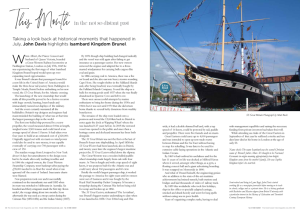Taking a look back at historical moments that happened in July, John Davis highlights Isambard Kingdom Brunel.

When Albert, the Prince Consort and husband of Queen Victoria, boarded a Great Western Railway locomotive at Paddington Station, London on July 27th, 1843 he was experiencing the first stage of what Isambard Kingdom Brunel hoped would open up ever-expanding travel opportunities.
It was Brunel’s dream that passengers bound for a new life in the United States of America would make the three-hour rail journey from Paddington to Temple Meads, Bristol before embarking on his new vessel, the SS Great Britain, for the Atlantic crossing.
The launching of the new steamship that would make all this possible proved to be a festive occasion with huge crowds, bunting, brass bands and immaculately turned-out displays of the military.
And the event certainly warranted all the hullaballoo. Britain’s top designer and engineer had masterminded the building of what was at that time the largest passenger ship in the world.
The first iron-hulled ship powered by a screw propeller, the vessel measured almost 100m in length, weighed some 3,500 tonnes and could travel at an average speed of about 11 knots. It had taken over four years to build at an estimated cost of £120,000. Originally rigged out with six masts so wind power could also be used to save money, it was capable eventually of carrying over 700 passengers with a crew of 130.
The maiden voyage from Liverpool to New York about 14 days but amendments to the design soon had to be made after early teething troubles and in 1846 the original owners, the Great Western Steamship Company, went bankrupt after paying the £35,000 needed to re-float the vessel when it ran aground off the coast of Ireland. Inaccurate charts were blamed.
New proprietors took over and it successfully continued on the transatlantic run until 1852 when its route was switched to Melbourne in Australia. Six hundred and thirty emigrants made the first trip ‘down under’, the voyage taking about two months. Soon afterwards she was used as a troop carrier during the Crimean War (1853-1856) and the Indian Mutiny (1857).
By 1876 though ship building had changed radically and the vessel was sold again after failing to get insurance as a passenger carrier. Her new owners removed the engines and adapted her to a three-masted windjammer for carrying bulk cargoes like coal and grain.
In 1886 carrying coal to America, there was a fire on board and she also ran into heavy storms rounding Cape Horn. She sought shelter in the Falkland Islands and, after being beached, was eventually bought by the Falkland Islands Company. It used the ship as a hulk for storing goods until 1937 when she was finally abandoned in Sparrow Cove and left to rot.
There were unsuccessful attempts by marine enthusiasts to bring her home during the 1930s and 1960s but it was not until 1970 that she did return home thanks to several hefty donations from wealthy benefactors.
The remains of the ship were loaded onto a pontoon and towed the 13,000km back to Bristol to enter again the dock at Wapping Wharf where she was launched 127 years before. In 2005 the restored vessel was opened to the public and since then a heritage centre and dockyard museum has been built alongside.

The SS Great Britain was not the first or the last of Brunel’s forays into shipbuilding. In April 1838 the SS Great Western had been launched, also in Bristol, and twenty years later the engineer’s largest maritime project the SS Great Eastern rolled down the slipway.
The Great Western was a wooden-hulled paddle-wheel steamship made largely from oak with four masts. At 76m in length and with a top speed of eight knots, it was purpose built for the Atlantic run and could carry about 160 passengers and 60 crew.
Briefly the world’s largest passenger ship, it worked the passage to America for eight years until its owners went out of business and it was bought by the Royal Mail Steamship Packet Company. It became a troopship during the Crimean War before being sold for scrap and broken up in 1856.
The SS Great Eastern, nicknamed ‘The Leviathan’, was Brunel’s biggest marine undertaking to date when it was launched in 1858. Over 200m long and 25m wide, it had a double skinned hull and, with a top speed of 14 knots, could be powered by sail, paddle and propeller. There were five funnels and six masts.
Great Eastern could carry up to 4,000 passengers and was intended to open up new trade routes between Britain and the Far East without having to stop for refuelling. It was later to be used for extensive cable laying operations in the Atlantic and Indian Oceans.
By 1869 it had outlived its usefulness and for the last 11 years of its life was docked at Milford Haven where it served, amongst other things, as a gym, a floating concert hall and a giant advertising hoarding. It was scrapped on Merseyside in 1890.
And what of Brunel himself, the engineering genius who in addition to his state-of-the-art maritime achievements had mined tunnels, built stations and bridges and laid thousands of miles of railway track.
By 1859 this workaholic who took few holidays, slept in his office or specially adapted carriage, smoked and drank heavily and went for long spells without eating was in poor health.
Years of organising complex tasks, having to deal with management squabbles and raising the necessary funding from private investors had taken their toll.
While attending sea trials of the Great Eastern in September of that year he suffered a stroke and ten days later died at his home in London at the age of only 53.

Name check: The name Isambard was the second Christian name of Brunel’s father, Marc. It’s thought to be Norman/Germanic in origin meaning appropriately iron-bright. Kingdom comes from his mother’s family. She was Sophia Kingdom before she married.



